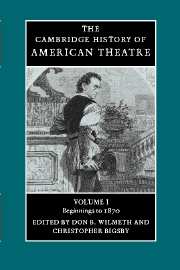Book contents
- Frontmatter
- Introduction
- Timeline: beginnings to 1870
- 1 American theatre in context, from the beginnings to 1870
- 2 Structure and management in the American theatre from the beginning to 1870
- 3 Plays and playwrights
- 4 The Actors
- European actors and the star system in the American theatre, 1752–1870
- The emergence of the American actor
- 5 Scenography, stagecraft, and architecture in the American theatre: beginnings to 1870
- 6 Paratheatricals and popular stage entertainment
- Bibliography
European actors and the star system in the American theatre, 1752–1870
from 4 - The Actors
Published online by Cambridge University Press: 28 March 2008
- Frontmatter
- Introduction
- Timeline: beginnings to 1870
- 1 American theatre in context, from the beginnings to 1870
- 2 Structure and management in the American theatre from the beginning to 1870
- 3 Plays and playwrights
- 4 The Actors
- European actors and the star system in the American theatre, 1752–1870
- The emergence of the American actor
- 5 Scenography, stagecraft, and architecture in the American theatre: beginnings to 1870
- 6 Paratheatricals and popular stage entertainment
- Bibliography
Summary
When trying to account for actors who have had a substantial impact on the history of the theatre, we frequently resort to metaphors of royalty. We refer to the finest performers of past generations as “player kings” or “queens” and allude to the stage and auditoriums over which they preside as personal “realms,” as if such spaces are determined primarily by the powerful allure displayed by the actor. We speak of the leading clans of the theatre world –the Kembles, the Booths, the Sotherns, or the Barrymores – as the “royal families” of the theatre. No doubt we do this in part because we feel the magnetism exercised by the most powerful actors’ calls for an unquestioning acceptance and loyalty, akin to the allegiance expected by monarchical authority, an appeal incidentally that few actors do much to counter. But our desire to make monarchs of stage performers may also have historical roots, in the close identity, especially strong in the eighteenth century, of acting troupes with royal patrons. In Europe, most actors who wished to achieve the social stature and respect that would ensure professional survival could do so only if they received the sanction of royalty. Their appearance on royally patented stages was even seen as a surrogate for the power of the prince himself.
In the early years of the American republic, this sense that actorial authority is somehow monarchical in nature casts the theatre into intriguingly anomalous light. As the newly independent nation grew, it emphatically asserted its freedom from royal shackles and assiduously constructed a political system, the principle aim of which was to ensure that relations between ruler and ruled were subject to constitutional limitations that guaranteed the rights of the individual citizen.
- Type
- Chapter
- Information
- The Cambridge History of American Theatre , pp. 303 - 337Publisher: Cambridge University PressPrint publication year: 1998
- 3
- Cited by



